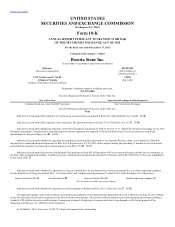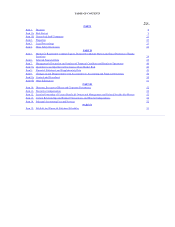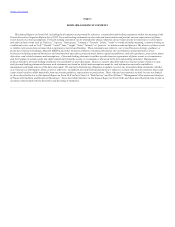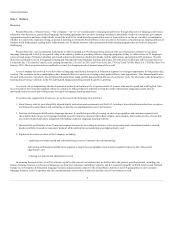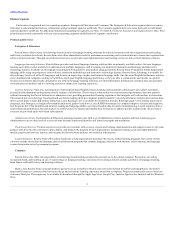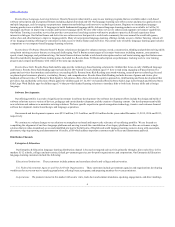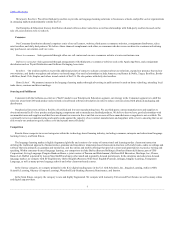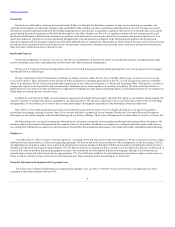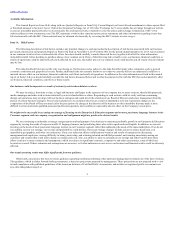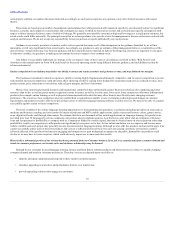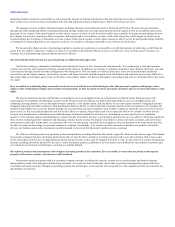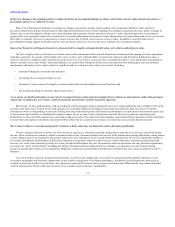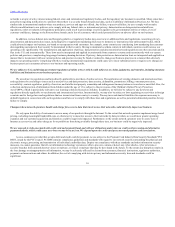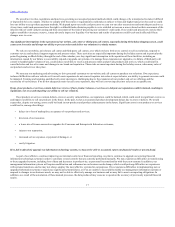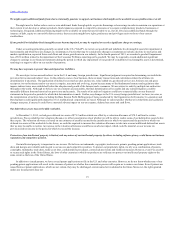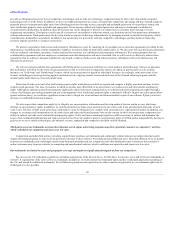Rosetta Stone 2015 Annual Report Download - page 11
Download and view the complete annual report
Please find page 11 of the 2015 Rosetta Stone annual report below. You can navigate through the pages in the report by either clicking on the pages listed below, or by using the keyword search tool below to find specific information within the annual report.
Table of Contents
outside party confirms or examines the projections and, accordingly, no such person expresses any opinion or any other form of assurance with respect
thereto.
Projections are based upon a number of assumptions and estimates that, while presented with numerical specificity, are inherently subject to significant
business, economic and competitive uncertainties and contingencies, many of which are beyond our control and are based upon specific assumptions with
respect to future business decisions, some of which will change. We generally state possible outcomes as high and low ranges or a single point estimates, but
actual results could differ materially. The principal reason that we release guidance is to provide a basis for management to discuss our business outlook with
analysts and investors. We do not accept any responsibility for any projections or reports published by any such persons.
Guidance is necessarily speculative in nature, and it can be expected that some or all of the assumptions in the guidance furnished by us will not
materialize or will vary significantly from actual results. Accordingly, our guidance is only an estimate of what management believes is realizable as of the
date of release. Actual results may vary from our guidance and the variations may be material. In light of the foregoing, investors are urged not to rely upon,
or otherwise consider, our guidance in making an investment decision in respect of our common stock.
Any failure to successfully implement our strategy or the occurrence of any of the events or circumstances set forth in these "Risk Factors" and
elsewhere in this annual report on Form 10-K could result in the actual operating results being different from our guidance, and such differences may be
adverse and material.
Intense competition in our industry may hinder our ability to attract and retain customers and generate revenue, and may diminish our margins.
The business environment in which we operate is rapidly evolving, highly fragmented and intensely competitive, and we expect competition to persist
and intensify. Increased competition could adversely affect operating results by causing lower demand for our products and services, reduced revenue, more
product returns, price reductions or concessions, reduced gross margins, and loss of customers.
Many of our current and potential domestic and international competitors have substantially greater financial, technical, sales, marketing and other
resources than we do, as well as greater name recognition in some locations, as well as in some cases, lower costs. Some competitors offer more differentiated
products (for example, online learning as well as physical classrooms and textbooks) that may allow them to more flexibly meet changing customer
preferences. The resources of our competitors also may enable them to respond more rapidly to new or emerging technologies and changes in customer
requirements and preferences and to offer lower prices than ours or to offer free language-learning software or online services. We may not be able to compete
successfully against current or future competitors.
There are a number of free online language-learning opportunities to learn grammar, pronunciation, vocabulary (including specialties in areas such as
medicine and business), reading, and conversation by means of podcasts and MP3s, mobile applications, audio courses and lessons, videos, games, stories,
news, digital textbooks, and through other means. We estimate that there are thousands of free mobile applications on language-learning; free products are
provided in at least 50 languages by private companies, universities, and government agencies. Low barriers to entry allow start-up companies with lower
costs and less pressure for profitability to compete with us. Competitors funded by venture capital, that may be focused more on user acquisition rather than
profitability, enable our competitors to offer products at significantly lower prices or for free. As free online translation services improve and become more
widely available and used, people may generally become less interested in language-learning. Although we also offer free products such as mobile apps, if we
cannot successfully attract users of these free products and convert a sufficient portion of these free users into paying customers, our business could be
adversely affected. If free products become more engaging and competitive or gain widespread acceptance by the public, demand for our products could
decline or we may have to lower our prices, which could adversely impact our revenue and other results.
Historically a substantial portion of our revenue has been generated from our Consumer business. If we fail to accurately anticipate consumer demand and
trends in consumer preferences, our brands, sales and customer relationships may be harmed.
Demand for our consumer focused language-learning, literacy and brain fitness software products and related services is subject to rapidly changing
consumer demand and trends in consumer preferences. Therefore, our success depends upon our ability to:
• identify, anticipate, understand and respond to these trends in a timely manner;
• introduce appealing new products and performance features on a timely basis;
• provide appealing solutions that engage our customers;
10

